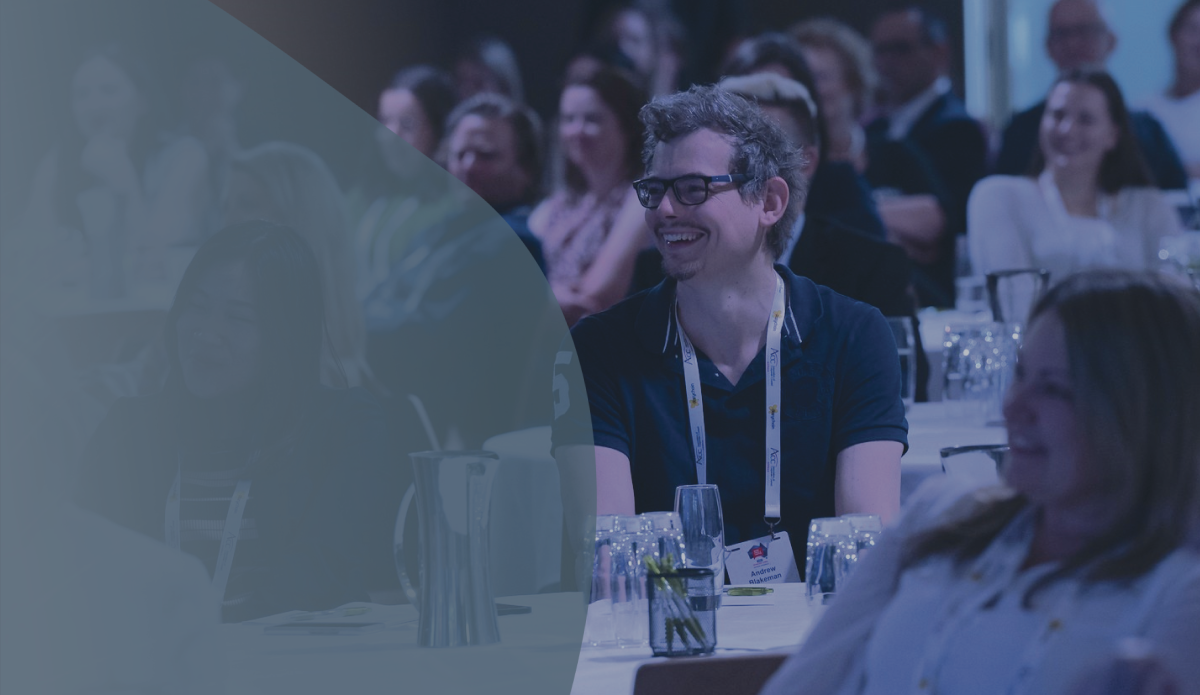Thursday Sessions
Changing the Narrative: The Importance of Altering Perceptions, Social Inclusion & Leadership Diversity
Dylan Alcott OA, Paralympic & World Champion – Inspirational Speaker
- Be Bold – put yourself out there and good things will come
- Process takes care of the result
- Only worry about what you can control
- Have fun going for your dream
- Passion and Purpose – build your platform to live out your purpose. Dylan’s purpose is to change perceptions so people with a disability can live the lives they deserve to live – for example,
- Don’t be afraid to ask questions
- With a little bit of effort and simply doing what you say you’ll do, you will change peoples’ lives
- Positive Perception – it’s not the events in life that dictate the life you live, it’s how you perceive them that determines the path that you take. It’s our decisions, not our conditions, that are most important. Look at the cards you’re dealt and become the best version of yourself
- Listen to lived experiences / inquisitiveness promotes inclusion
Engaging an Expert: Don’t leave it to chance
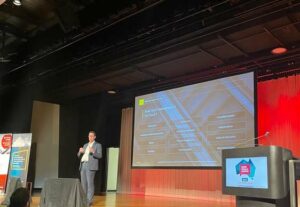
Campbell Jackson – EY, with insights from the client’s perspective from Kate Carlile – Toll, and Malcolm Haack – Orica.
- Preparation is key – the earlier you prepare, the better you’ll be.
- Ideally, you’ll have your preferred experts already identified, engaged and suitably across your business before the trigger event occurs
- Choose the right expert with the right experience and also the discipline to focus on their area of expertise
- Communication is critically important and always keep your desired end point in mind
Panel – Impact of the new government on employment law
Commissioner Jennifer Hunt – Fair Work Commission, Neil Henderson, Secretary – Australian Services Union, Julie O’Brien, General Counsel – Australian Human Rights Commission and Bernadette Doyle, Manager, Legal Counsel – Seqwater
To assist in-house counsel getting ready for employment law changes coming under Secure Jobs, Better Pay Bill, the panel discussion touched on:
- Positive duty to take reasonable and proportionate measures to eliminate sexual harassment in the workplace, to apply as an end-to-end framework in a mutually reinforcing way with current WHS laws
- Pay Equality and prohibition of pay secrecy clauses
- Multi-employer bargaining
- Flexible workplace arrangements
- Ending of zombie agreements
- Amendments to Better Off Overall Test (BOOT) to ensure assessment is simple, flexible and fair
Roundtable – Rethinking in-house legal – how to create a more connected and fulfilled function
Shaun Plant, Chief Legal Officer at LawVu
Why do people move in-house: variety of work / from start to finish / directly see the results.
In-house legal function is maintaining the machine. External legal is fixing a broken component of the machine.
Some ways to improve the connection with the business:
- Let the business know about work you do for other functions across the business, not just theirs
- Set up a service level agreement internally with the business
- Contract managers can be useful – train them up and embed them within business units
- Self-help tools – give the business the power
- One point of contact/entry for requests from the business so requests can be triaged and prioritised, but take care to introduce the portal without distancing yourself from the business; show business units how it helps them / do floor walks and engage in other ways.
Don’t be boring: Creative communication for lawyers
Frances Hoskins, General Counsel at the Australian Institute of Marine Science, and Andrew Paloni, Special Counsel – Major Projects at the Australian Institute of Marine Science
Finding engaging and creative ways to communicate legal matters to non-lawyers within the business is vital as an in-house lawyer. Making information that would usually be boring, interesting starts by asking two questions: who is my audience? And what do I want or need them to know?
Good communication is a gift, when you are communicating with others, especially as an in-house lawyer, you want to ensure people feel empowered, smart, and confident. Clarity, accessible language and communication will empower non-lawyers within the business to ask questions and act on legal advice. The Communication Toolbox is a great resource to inspire creativity as in-house counsel.
Communication toolbox:
- Storytelling – incorporate stories into your legal advice. Use storytelling to communicate the goal to the business and explain the role they play in achieving that goal.
- Humour – starting out with a joke will prime people to listen; it’s a great way to communicate the most important point you want people to takeaway and remember.
- Interactivity – making a presentation more conversational includes the audience, letting them drive by asking questions means you can jump straight into what they care about.
- Tactile or visual communication – drives engagement, makes people pay attention and encourages curiosity.
- Creative ways to present information – if you think a topic is boring, your audience most likely agrees. Using things like videos, factsheets, PowerPoints, and quizzes to present legal advice/information can make it more accessible to everyone within the business.
Welcome to the Metaverse

Schellie-Jayne Price, Legal Technology and Innovation Chair – ACC Australia
The metaverse fuses our digital and physical life. It’s the future, but it’s currently operating in a legally complex grey area. As the virtual world becomes more sophisticated and intertwined with our everyday lives, influencing and advising on the grey areas surrounding law in the metaverse will be paramount for in-house lawyers.
Fast facts about the Metaverse:
- Over 40 million users
- Average age in the metaverse is 13 years old
- McKinsey forecasts that it will be worth $5 trillion by 2050
- Land in the metaverse is selling for $500K – $3.5 million
- Corporations are starting to explore the Metaverse and use it to engage younger audiences, for example:
- Accenture – over 150,000 new staff were onboarded virtually through ‘One Accenture Park’ where they completed training modules and interacted with colleagues.
- The Australian Open – held a virtual hosting of the AO in Decentraland, where fans could experience the event. The AO saw the need for real engagement between the physical and virtual world and gave users the opportunity to purchase NFP digital art tennis balls that each correlated to a plot of land on the real court.
Practical Insights for In-house Lawyers:
- Include metaverse risks in cybersecurity plans and policies
- Determine key exposures in metaverse platform Terms of Use
- Refresh HR/HES policies to include metaverse interactions and use of enabling technology
- Metaverse incidents included in incident response training
- Audit brand IP and potentially expand fillings to protect virtual goods and services
Investing in your most valuable asset (your people) and nurturing a strong employment brand
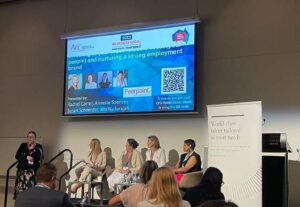
Panel: Rachel Carter – PeerPoint, Annette Spencer, General Counsel – Barrenjoey, Susan Schenieder, Chief Legal & Risk Officer – Virgin, Niti Nadarajah, Freelance General Counsel and Coach – Legal by Niti
- Some ways to help attract talent:
- Head office in Australia is seen as attractive to potential candidates
- Clear and evident passion and purpose
- values that are simple and accessible
- Offer part time / flexibility
- Ensuring recruiters are well briefed
- Build your own personal profile to attract talent too and remember to make sure your LinkedIn profile is up to date – applicants will look at it
Your Paramount Duty
The Honourable Justice Martin Daubney AM
- A fascinating exploration of the Paramount Duty of Lawyers to the Court and the case law surrounding its status as the bedrock of the justice system.
- Ethics are paramount for the profession and should be taught early in law school
- Ethics should not be sacrificed for commerce
- High Court – There is NO tension between the duty to the client and duty to the Court – the duty to the court is paramount
Friday Sessions
Managing change: Insanity, intelligence and inspiration
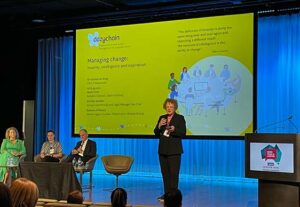
Dr Katherine King, Chief Executive Officer – Dazychain, Mark Flint, General Counsel – Geocon, Kirrilly Gordon, Group Commercial and Legal Manager – SEE Group, Gemma O’Meara, Senior Legal Counsel – Fitness Lifestyle Group
Technology has been an important component in getting through the pandemic. We’ve moved from letter, to fax, to e-mail. Technology can be used to demonstrate to the business what legal is doing and for the legal team to understand the volume of work they have. Creates one source of truth.
One way to use technology is to have a central intake system for all legal issues. Business was initially resistant but now works well – but need consistency and all team members to push back on business from going around the central intake. Have an open-door policy for business to connect with legal and people can call. It helps to have executive endorsement when implementing new technologies.
When implementing new technology, break it down, get collaboration, and have a quick win initially. Also do research, look at cost and build a relationship with IT.
Is technology a cause or solution to misery? Both – depends how it’s used.
Industry 5.0 & The Advancement of Ethical Tech
Dr Catherine Ball, Scientific Futurist
We’re in Industrial Revolution 5.0. Will go for 10 years. 4.0 was pre covid, 5.0 – scaling tech and technology of the body – implants. Contact lenses as cameras, screens on arms, brain synthesis – upload data into brains. It won’t be long before face identification technology will be linked to payment.
The technology is there and available, it just needs to be scaled and put in place. So much tech could be used in hospitals and health that could make a massive difference, for example, waiting rooms in hospitals, carbon neutral shipping.
Bill Gibson – The future is here, it’s just not evenly distributed.
Lawyers will have work to do because as long tech changes there will need to be laws for the technology and its use.
Meta verse – can create a Digital Twin. Tasmania about to create a digital twin for scenario testing. Industry 6.0 – quantum and Gaia theory – Digital twin of the earth.
“Converge” – book by Dr Catherine Ball.
Disability Inclusion Action Plans: What are they, why do you need one and how do you write one.
Panel: Jane Spring, Chair – NSW Disability Council, Lori Middlehurst, Senior Director for Global Employment Law (Asia Pacific) – Salesforce, Karen Grumley, Manager Corporate Governance & Compliance – Pacific National
Low rates of employment and engagement by disabled Australians are at the forefront of the Albanese government agenda.
A Disability Inclusion Action Plan (DIAP) outlines the way an organisation will ensure its goods, services, workplace, premise, and facilities are accessible, inclusive and even welcoming to people with disabilities.
So much good can come from creating and implementing a DIAP, not just for those with a disability but for the organisation, employees and society.
Start with an audit and consider bringing in external specialists and resources to implement your DIAP. Even before a DIAP audit an easy place to start is to ensure physical accessibility. Action plan templates are also available online if you don’t know where to start. The plan should be simple, achievable and go beyond HR to involve the whole business. Share stories and experience and look at what can be done better.
Insert provisions for your DIAP into contracts alongside provisions like modern slavery.
Tech will make a big difference – working remotely, and driverless cars will give those with disabilities more freedom.
Most importantly – Start the process!
Roundtable – Is hybrid working increasing the risk of cultural toxicity?
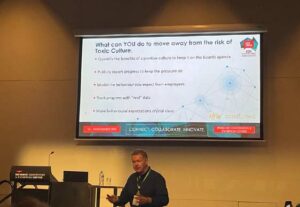
Chris O’Callaghan, Director of Consulting – HFW Consulting
- Hybrid working attracts talent but may risk eroding culture, so need conscious effort to make people feel connected
- Toxic corporate culture results in range of organisational costs including:
- Higher employee attrition
- A poor employer brand makes it harder to attract talent
- Employees are disengaged and less productive
- Higher healthcare costs hurt employer’s bottom line
- Risk of reputational damage and legal liability is higher
- Model the behaviour you expect and call out negative behaviour
- Make incremental changes to improve
Is it smart to use a smart legal contract?
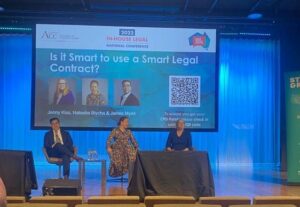
Jenny Kiss, Natasha Blycha and James Mynt – Stirling & Rose
The next 5-10 years will be an exciting time for technology, AI and the Metaverse, it’s important that in-house lawyers start to practically consider what changes they need to make and how they will adapt to the new technological environment.
A smart legal contract includes natural language (words/text) with code, and contractual obligations are defined and/or performed automatically by a computer program. Smart Legal Contracts collect data that is quantifiable, providing a single source of truth, and operate as a kind of ‘magic filing system’.
Requirements of a Smart Legal Contract:
- Legally binding in that jurisdiction
- Digital and machine readable
- Includes both natural language and code
- Active function – how, when, and why the contract works
- Digital execution mechanism – how it integrates with the active function
While smart legal contract software is not yet readily available and accessible, in-house lawyers can start to prepare for the transition to Smart Legal Contracts by:
- Making meaningful operational changes,
- Mapping where the contracts are within the business,
- Organising an innovation project where you begin to evaluate where automation would be valuable within your existing contracts.
Panel – Legal advising for a pandemic

Stephen Bouwhuis, General Counsel in the Commonwealth Department of Health, Steve Webber, First Assistant Secretary Disputes and Corporate Law – Legal Group, Department of Home Affairs & Lisa Keeling, General Counsel – Australian Digital Health Agency
The pandemic placed enormous strain upon the legal capacity of the government. There were queues at CentreLink that went for kilometres and the MyGov website crashed, the ADF was deployed, and roles changed overnight. Media pressure was intense and eligibility criteria for payments was changing overnight.
Lawyers were redeployed across different areas; time frames were accelerated, and massive change happened incredibly quickly. There was forgiveness in not getting things perfect.
A separate legal team was established within the government to distribute and track legal work. It forced everyone to look at the larger system and adjust their risk appetite to the business risk appetite.
The legal teams were successful because they worked together as a team and “got on with things”. Networks and delegation became crucially important to avoid becoming overloaded and external law firms plugged many of the gaps, and they did it well, worked collaboratively.
Mental health is extremely important – it’s a marathon not a sprint, try to maintain a routine and watch for danger signs of mental health in you and your colleagues.
Lore, Law & Lawyers V2.0
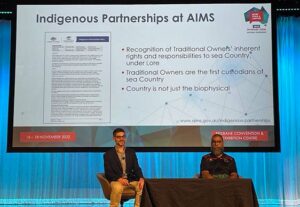
Andrew Paloni, Special Counsel – Major Projects at AIMS & Bob Muir, Indigenous Partnerships Coordinator at Australian Institute of Marine Science
- Practical example of bridging the gap between First Nations Lore and Australian Law
- As part of the Australian Institute of Marine Science’s (AIMS) leading Indigenous Partnerships program along the Great Barrier Reef and across tropical northern Australia, AIMS goes beyond the Law to also seek compliance with the Lore
- Importance of Free, Prior and Informed Consent (FPIC)
- How you can help your organisation’s relationship with Aboriginal and Torres Strait Islander peoples: incorporate legally binding protections for knowledge / ensure effective consent is obtained / develop systems to support genuine partnerships / promote ethics and respect
Carbon Counting – Counsel’s Role
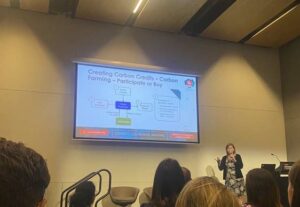
Suzanne Dickey, Senior Legal Counsel at Beach Energy
Emission reporting, carbon counting and ESG disclosure are becoming increasingly important for corporations. Regulatory bodies are cracking down on green-washing; shareholder activism is leading to litigation; and the nation tries to reach its net-zero emission targets by 2050. As in-house legal counsel, it’s important to stay on the forefront of these issues and understand how they affect your business.
The role of in-house counsel:
- Reporting – find out which regulations apply to your business, ensure all reporting is accurate and determine who is responsible for the accurate reporting within the business.
- Advising – advise the board and leadership team to put together sustainability reports, avoid greenwashing and include ESG considerations in their long-term strategy.
- Procurement and Operations – Compare and consider emissions when purchasing equipment and procuring goods. Work with the operations team to explore ways to lower the emissions of current practices.
- Commercial strategy – Involve all levels of the business and work on embedding sustainability as a company value and part of long-term strategy.
- Carbon literacy – Improve your understanding of relevant regulations – the Clean Energy Regulators website is a great place to start, plan and forecast company emissions, and investigate the Carbon Market where individuals, companies and governments are farming and purchasing carbon credits to offset their carbon emissions.
Stronger Together: how connections illuminate hope amongst uncertainty
Mark Berridge, Author, Speaker and Lived Adversity Expert
- From a lived experience of adversity comes the strength of drawing on: warmth from the past / perspective of the present / inspiration for the future.
- Importance of a recovery mindset: what are you ultimately seeking to achieve / what is your drive to get there / how do you feel about the way ahead. An appreciated awareness of your “lanterns, angels and demons”.
- Adopt positive mantras to turn the negative into a powerful force.
- Life is imperfect and people achieve exceptional things from imperfect positions every day.
“A Fraction Stronger” – book by Mark Berridge
On Being Your Authentic Self, Tough Conversations and Leadership
Catherine McGregor AM, Writer, Commentator and former Australian Defence Force officer.
A broad ranging and poignant talk about leadership. The need to lead from the front – an Army Base in USA with a statute – inscribed with “Follow me”. Catherine examined the difference between management and leadership and shared many heartfelt examples of inspirational leadership she had witnessed in the ADF.
Good leadership can make a huge difference within an organisation.
As an example of how leadership can inspire Catherine recited St Crispin’s Day speech before the 1415 Battle of Agincourt by William Shakespeare, 1599:
But we in it shall be remembered –
We few, we happy few, we band of brothers;
For he to-day that sheds his blood with me
Shall be my brother; be he ne’er so vile,
This day shall gentle his condition;
And gentlemen in England now-a-bed
Shall think themselves accurs’d they were not here,
And hold their manhoods cheap whiles any speaks
That fought with us upon Saint Crispin’s day.
_______________________
Well done to the ACC Australia team and everyone involved. It was great to be back in person and enjoy another successful ACC National Conference!















